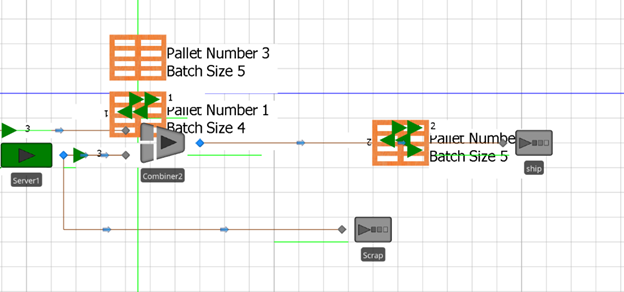Search the Community
Showing results for 'combiner parent'.
-
Hello everybody, I'm trying to make this work but I cant Type/Conteiner BinBig BinMed BinSmall Product1 1 1 - Product2 - 1 1 Product3 1 - 1 Product4 1 1 1 I want to make a node where these entities (Products and Bins) are convined in one batch, I try to use a process based in decitions and search.. the file is attached if you wanna take a look on it.. (the product have to be the parent) OptimoContenedores2.spfx
-
Hello everyone: I am modeling a packaging system by means of a combiner. 12 equal members are grouped in a box (parent). Before leaving the respective source, members are assigned a value (0, 1, 2) as a state variable (ESV_P) to distinguish them by product type. I want the box to have the value of the products state variable. For example, if the box contains 12 type 1 products, the box should be assigned with a state variable ESV_B equal to 1. Any suggestions? Best regards.
-
Got issues with a combiner. i have a server that processes the member parts but has a 0.1 probability of going to scrap, this means the batch size has changed. the parent part has a integer state that gets updated when this happens but doesn't update the combiner batch quantity property. I have attached an image showing this issue. you can see the pallet number displayed which is the way i match the parts with the correct pallet. the pallet(parent) also displays the batch size using the same integer state which i use in the combiner logic. Theres a pallet with 4 items on it and it shows the batch is 4 so why wont that process it? Also attached the whole model so you can look at it all Batch and Scrap.spfx
-
Generating new entinty in combiner
Khaled Khamis replied to xdabroar's topic in SI General Discussions
Hi, A combiner is able to combine 1 or more entities into a parent entity. The number of entities that are batched together is specified in the property Batch Quantity. I recommend looking at the SimBit "Combine Multiple Entity Types Onto Pallets" for an example. Best, Khaled -
Accessing parentinputbuffer time waiting combiner
ViniciusF replied to piedz's topic in SI General Discussions
Is it fair to say that the longest waiting time in the parent queue is the first entity at the queue? If so, you could use something like: Candidate.Node.AssociatedObject.Combiner.ParentInputBuffer.Contents.TimeWaiting(Candidate.Node.AssociatedObject.Combiner.ParentInputBuffer.Contents.FirstItem) to access the combiner which has the largest value of the time waiting of the firstItem in the queue. It seems to work -
Hey, I've got a quick question on how to route to a combiner with the longest waiting time in their parent queue. I think it should be quite easy, but i cant seem to make it work. What i have been doing is setting the selection goal of my routing node to largest value, and select from a list. This largest value I think should be the the longest waiting time in the contents of the parentinput queue. I have tried this multiple ways both using assosiated object and without. When i recall the number waiting it seems to work, but with recalling the waiting time i'm doing something wrong. My current expression is: Candidate.Node.AssociatedObject.Combiner.ParentInputBuffer.Contents.TimeWaiting(ModelEntity) or Candidate.Combiner.ParentInputBuffer.Contents.TimeWaiting( object ) both seem to work for content.numberwaiting. I think i am describing the ( object ) part wrong but cant find how i should write for the modelentity otherwise. I have tried to recall a specific entititype like so --> TimeWaiting(Truck) this also does not work. Does somebody know how i can acces the ParentInputBuffer.Contents.TimeWaiting? Greeting Piet
-
You need to put the search, release and transfer steps into the Add-on Process Triggers "Parent Entered" of the Combiners. For example, for the "Juntar_secos" combiner, at the "Parent Entered" Addon process, you would search for Slots.Processing.Contents, matching "Candidate.ModelEntity.Id_Del_Pedido == ModelEntity.Id_del_pedido". After that you should use a release step, to release Server "Slots", and a transfer step to transfer what have been found to Output@Slots.
-
Well, first thing, you don't need your entities to be bouncing between the output and the input of your server like that. If you want to use it as sort of storage, set both the processing time and the capacity to infinity. After that, at the moment that the parent entity enters the combiner "Parent Entered" you could search the queue of your storage using a search step with something like "Server1.Processing.Contents", with the condition of "Candidate.ModelEntity.State == ModelEntity.State", release the server and transfer what have been found to the output. You need to take some care on some situations, like what if the parent entity arrives first at the combiner then the member at the storage? And some care with batching quantities aswell. But I think you can handle it.
-
Hi! In my model I have entities called "Pedido" which have a state called "id_del_pedido" which is equal to the ID of the entity. These entities will enter a Separator that will create copies of the entity according to a probability distribution. Since the new entities are copies of the parent entity, they will have the same "id_del_pedido" status as the parent entity. Subsequently, the entities created will enter a Server that acts as a warehouse. This Server is linked to a Combiner, when the parent entity reaches the Combiner's parentinput I want only entities whose "id_del_pedido" is equal to the ID of the entity that reached the Combiner's parentinput to leave the server. This works perfectly in the first Server-Combiner set of my model, but, the Combiner's outputnode is attached to another Combiner and I want to repeat the same activity as in the first Combiner but I get an error that I don't know how to solve. I attach my model so that my problem is better understood. Thank you very much in advance! 18.10.spfx
-
Hi! can you help me please? In my model I have a server that I want to function as storage, this server is linked to a combiner which will combine the member entities that leave the server with a parent entity that will arrive at it from another node. Each member entity has a state with a unique number linking it to a parent entity (there may be more than one member entity with the same state number). How can I extract from the server only the member entities whose state is equal to the state of the parent entity that arrives at the parentinput of the combiner? Thank you so much! 18.10.spfx
-
Hello Everyone, please can someone help me with this situation? I want to use a Server as a storage place, entities coming out of it go into the MemberInput of a Combiner. I want the number of entities that leave the Server to depend on the state of the entity that will enter the ParentInput of the Combiner. How can I access the state of the parent entity that will enter the combiner from the Output Node of the Server? Thank you very much, Greetings! 14.10.spfx
-
Hi, I have a production line with 2 sources. The arrival of entity A in source 1 triggers an arrival of entity B in source 2. Entity A and entity B then enter their respective servers for a processing time. Entity A is processed at table_openings between 10 and 15 minutes with probabilities whereas Entity B is processed at table_MF for 10 minutes. The process type is task sequence. Both Entity join at a combiner. Entity A is the parent and Entity B is the member. Afterwards, the combined entity continue along the production line. I have expected processing times for each task at each server. Before starting a task, a process starts where a state statistic registers the state processing time of the entity. I also put list state to verify the schedule utilization. I have verified visually and the state value for processing time is correct for every station while the simulation is running. What I have observed is that the state statistic average processing time for the servers before the combiner is the expected value, however, all the other stations are 10 minutes off. The simio output has the right processing times for all the stations after the combiner but not for the two stations before the combiner. Moreover, the list state average time busy value are ok for all the stations after the combiner but again the station before the combiner, it gives the total number of minutes it was busy. Also, if i do the average of the state log observation for each station in excel afterwards, I get all the correct processing times. I am guessing it has something to do with the combiner, but I am lost. How can the processing time for table_MF be 10,48 when the processing time is a fixed 10 minutes in the facility window? Why is the list State MF and OP different from all the other list states? Thank you for your help!
-
I have a system with 3 steps. At each step a certain amount of product is process and batched (using a combiner) on to a pallet. I have to assign a sequence table to the member entities and the parent (pallet) entities. However this is resulting in some batches sitting at a combiner because the pallet follows the sequence instead of going to the next batch ready if the pallet is empty. Any thoughts on how to handle this? If there is no call for an empty pallet the pallets could stay where they are or go to a specific location.
-
Hello, I ran into a similar problem and am finding it difficult to construct a match expression for the combiner. I want to model a gear assembly GA(parent node) with gear g1, g2, and g3 (all connected to member node). But, there is some upstream variation affecting mating of gears. So, business process is binning them say g1-bin1 through g1-bin5. Similarly g2-bin1 through g2-bin5 and g3-bin1 through g3-bin5. I am currently using matching bin expression but stuck with the combiner is giving me GA1 = g1-bin2, g1-bin2, g2-bin2 which is wrong. How can I tweak so that I can get GA1 = g1-bin2, g2-bin2, g3-bin2. To be clear - There are thousands of g1, g2 and g3 (outsourced parts). I do not want to match some 'source entity counter' because that would assign a unique number to each gear and over-constrain the matching process. Again this might be a rather simple problem but as a beginner modeller I would appreciate a quick hint. Thanks, Hrushi
-

Conditional Routing (by link weight) is not working
ATSProThiede replied to AlexDCave's topic in SI General Discussions
*If you need a custom logic, because you have a lot of batch members, you can add a entered process in the node. Then you can use a search step and search your right member. Then you can use a Decide-Step or what else and use the "SetNode-Step" and not the link weight logic. So you can set the taget destionation with the SetNode-Step :-). Or, you write the state in the Parent-Entity after these Entitiy left the Combiner. They are different options to solve this problem. -
I have recreated a system to see theoretical capacities and it has multiple sources (1 parent and 2 different members that I combine). I have turned off balking because that interferes with my unit mix. I have also changed all buffers to a finite number and crossing logic capacities to 1. Even with all of this, I still hit the 2500 max entities and an error pops up. This system should only be able to hold a couple hundred, so I know I don't need to adjust my capacity size. I made the units stop at the 1st server so I could isolate the issue and it appears to be upon creation or in the combiner. My question is, how can I have unit production pause (not stop) when the buffers and capacities are full? I have attached the file for reference. APS Design 2.spfx
-
Hi, I believe you approach is correct. I would suggest you look at the CombineMultipleEntityTypesOntoPallets Simbit for help on how to have the shirts be combined with the totes (this may help alleviate your confusion about the worker fetching totes instead of shirts). Another suggestion would be the think of the combiner in a slightly different way than the real system (parent object, like the pallets in the above node) and the shirts are then feed into the member input and combined when there are 5 shirts. Meaning the shirts are combined with the tote, then once 3 totes are filled the ARM can move them out (utilizing an evaluating seize request add-on process for the ARM transporter). Hope this helps. Jason
-
You can sum the "NumberOfRollContainers" whenever a member entity enters the combiner object by using "on member entering" property under "state assignments" section. Then, set this total to the "TotalRollContainers" state variable of the parent objet by using "before exiting" property of combiner object.
-
Hello All, This is my first post and I am relatively new to the program, so my apologies if my strategies are not the best. Essentially what i am trying to simulate is a simple picking process with AMRs (automated mobile robots). The ideal workflow is: 1. 3 Totes are created and attached to ARM's shelves 2. Shirts are created and processed through a server (already done) 3. Worker picks 5 shirts from the servers (already done) 4. Worker takes the 5 shirts and places it on the Totes 5. Once the 3 totes are full, the AMR will navigate to an unloading destination so another worker can unload the boxes So i realized that simio does not have any "attach" features where i could attach a box to a robot so instead of attaching, i will just make a combiner near the robot of the totes and shirts that its output leads to the unloading destination via transporter AKA the AMR So far, I have been able to create shirts, put them on servers and have the worker pick and place them. I have been looking into using a Combiner to merge the totes and the shirts, but for some reason the worker keeps fetching totes and not shirts (yes, I set the Batch Quantity to 5, so the worker should fetch 1 totes and 5 shirts right?). I simply need one tote/5shirts and would like the process in that order, in other words, the worker fetches a box places it on the robot ("feeds the parent input of the combiner") and fetches for 5 shirts to place on the box ("feeds the member input of the combiner"). Im more worried about these first steps, i know it may take more understanding to have the robot move once the 3 boxes are full. Any help, helps. Thank you.
-
If the parent entity knows how many bags belongs to they, you could set this expression in combiner's Batch Quantity property, something like my new attached model. Then you set the bag and passager IDs in the Ranking Rule property. Match Quantity.spfx
-
Thank you for your help, though this does not work for my model. The amount of (member)entities that are batched differs (since the amount of bags that a passenger carries with them differs), i am able to make sure the parent entity "knows" how many bags they should batch with at the combiner, but i can only get 1 right member entity to batch. so what i would like to do is give all member entities that "belong to a passenger" a state which is the same as a state for the parent entity (passenger), so this can be used as "match expression".
-
I want to assign a state variable to the batch members of a parent entity, is this possible? the reason for this: I have 2 types of entities (passengers and bags), they separate, then go through different processes and then are combined again. but since the passenger entities have to be combined with "their own" bags, a state (or something else) should be assigned which can be referenced as "match expression" in the combiner. is this the right way of modeling this type of process? or should i do this another way?
-
I want to simulate a touring group utilizing 2 different buses to the same destiny, concurrently there are multi-types of model entities with a unique percentage distribution; "Adult, Teen and Senior", passengers. Finally, at arrival, both groups unloaded from their buses at the same time. My Question is: How I can to batch each group in a separate assembling area, so then they would follow a different group routing? I studied the "Combiner Node" example in the SimBit, can I do it without parent priority logic?
-
I will try to use the match expressions to determine which containers to batch. It would make things simpler. In the meantime, I discovered I could insert an extra server with 0 processing time just to store the worker and trigger the processing. Then, if a member entity is ready to batch, the worker can perform the batch. If there is no member entity yet, the worker waits in the output buffer and then when the member entity arrives at his detached queue (I needed to add that back in for this to work) it transfers the worker back to the input of this server so the worker can execute the batching logic again. Then, the parent and members arrive together at the combiner and they're ready to be combined. Again, I'll try again to use the match expressions, but if I can't figure that out, this should suffice. thank you very much for your help. using combiner.spfx
-
1) The model seems working as you intended. The animation seems the logic is not working but in fact the animation is delayed (in the animation the modelentity is at output node of server2 i.e., seems behind the scheule but if you examine trace window the modelentity is just at combiner memberinput buffer.) 2) I think the process logics are not required if you will not use them for further modeling purposes. I mean If you set appropriate parent match expression and member match expression at combiner1 object, the object itself will combine them automatically (it will perform all the operations you performed in your processes). Try not to use them?






